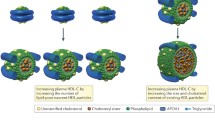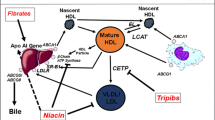Abstract
Several known functions of high-density lipoproteins (HDLs) may contribute to their ability to protect against atherosclerosis. The best known of these functions is the ability to promote cholesterol efflux from cells in a process that may minimize the accumulation of foam cells in the artery wall. However, HDLs have additional properties, including antioxidant, antiinflammatory, and antithrombotic effects, that may also be anti-atherogenic. Recent in vivo studies in several animal models have demonstrated that HDLs can inhibit acute and chronic vascular inflammation. The fact that these effects can be achieved with very low doses of reconstituted discoidal HDL or even lipid-free apolipoprotein A-I suggests that they may reflect activity of a minor, highly active HDL subpopulation. These results have potentially important clinical implications in regard to managing the acute vascular inflammation states that accompany acute coronary sydrome and acute ischemic stroke.
Similar content being viewed by others
References and Recommended Reading
Gordon T, Castelli WP, Hjortland MC, et al.:High density lipoprotein as a protective factor against coronary heart disease: the Framingham Study.Am J Med 1977,62:707–714.
Miller M, Seidler A, Kwiterovich PO, Pearson TA:Long-term predictors of subsequent cardiovascular events with coronary artery disease and “desirable” levels of plasma total cholesterol.Circulation 1992,86:1165–1170.
Badimon JJ, Badimon L, Fuster V:Regression of atherosclerotic lesions by high density lipoprotein plasma fraction in the cholesterol-fed rabbit.J Clin Invest 1990,85:1234–1241.
Pászty C, Maeda N, Verstuyft J, Rubin EM:Apolipoprotein AI transgene corrects apolipoprotein E deficiency-induced atherosclerosis in mice.J Clin Invest 1994,94:899–903.
Plump AS, Scott CJ, Breslow JL:Human apolipoprotein A-I gene expression increases high density lipoprotein and suppresses atherosclerosis in the apolipoprotein E-deficient mouse.Proc. Natl Acad Sci USA 1994,91:9607–9611.
Rubin EM, Krauss RM, Spangler EA, et al.:Inhibition of early atherogenesis in transgenic mice by human apolipoprotein AI.Nature 1991,353:265–267.
Duffy D, Rader DJ:Emerging therapies targeting high-density lipoprotein metabolism and reverse cholesterol transport.Circulation 2006,113:1140–1150.
Durrington PN, Mackness B, Mackness MI:Paraoxonase and atherosclerosis.Arterioscler Thromb Vasc Biol 2001,21:473–480.
Spieker LE, Sudano I, Hurlimann D, et al.:High-density lipoprotein restores endothelial function in hypercholesterolemic men.Circulation 2002,105:1399–1402.
Bisoendial RJ, Hovingh GK, Levels JH, et al.:Restoration of endothelial function by increasing high-density lipoprotein in subjects with isolated low high-density lipoprotein.Circulation 2003,107:2944–2948.
Suc I, Escargueil-Blanc I, Troly M, et al.:HDL and ApoA prevent cell death of endothelial cells induced by oxidized LDL.Arterioscler Thromb Vasc Biol 1997,17:2158–2166.
Sugano M, Tsuchida K, Makino N:High-density lipoproteins protect endothelial cells from tumor necrosis factor-alpha-induced apoptosis.Biochem Biophys Res Commun 2000,272:872–876.
Speidel MT, Booyse FM, Abrams A, et al.:Lipolyzed hypertriglyceridemic serum and triglyceride-rich lipoprotein cause lipid accumulation in and are cytotoxic to cultured human endothelial cells: high density lipoproteins inhibit this cytotoxicity.Thromb Res 1990,58:251–264.
Hui DY, Noel JG, Harmony JA:Binding of plasma low density lipoproteins to erythrocytes.Biochim Biophys Acta 1981,664:513–526.
Lerch PG, Spycher MO, Doran JE:Reconstituted high density lipoprotein (rHDL) modulates platelet activity in vitro and ex vivo.Thromb Haemost 1998,80:316–320.
Rosenson RS, Lowe GD:Effects of lipids and lipoproteins on thrombosis and rheology.Atherosclerosis 1998,140:271–280.
Seetharam D, Mineo C, Gormley AK, et al.:High-density lipoprotein promotes endothelial cell migration and reendothelialization via scavenger receptor-B type I.Circ Res 2006,98:63–72.
Of major importance Tso C, Martinic G, Fan WH, et al.:High-density lipoproteins enhance progenitor-mediated endothelium repair in mice.Arterioscler Thromb Vasc Biol 2006,26:1144–1149. This study identifies a novel, potentially protective role of HDLs in promoting the recruitment of circulating endothelial progenitor cells into damaged endothelium.
Cockerill GW, Rye KA, Gamble JR, et al.:High-density lipoproteins inhibit cytokine-induced expression of endothelial cell adhesion molecules.Arterioscler Thromb Vasc Biol 1995,15:1987–1994.
Calabresi L, Franceschini G, Sirtori CR, et al.:Inhibition of VCAM-1 expression in endothelial cells by reconstituted high density lipoproteins.Biochem Biophys Res Commun 1997,238:61–65.
Xia P, Vadas MA, Rye KA, et al.:High density lipoproteins (HDL) interrupt the sphingosine kinase signaling pathway: a possible mechanism for protection against atherosclerosis by HDL.J Biol Chem 1992,274:33143–33147.
Ashby DT, Rye KA, Clay MA, et al.:Factors influencing the ability of HDL to inhibit expression of vascular cell adhesion molecule-1 in endothelial cells.Arterioscler Thromb Vasc Biol 1998,18:1450–1455.
Baker PW, Rye KA, Gamble JR, et al.:Ability of reconstituted high density lipoproteins to inhibit cytokine-induced expression of vascular cell adhesion molecule-1 in human umbilical vein endothelial cells.J Lipid Res 1999,40:345–353.
Baker PW, Rye KA, Gamble JR, et al.:Phospholipid composition of reconstituted high density lipoproteins influences their ability to inhibit endothelial cell adhesion molecule expression.J Lipid Res 2000,41:1261–1267.
Maier JA, Barenghi L, Pagani F, et al.:The protective role of high-density lipoprotein on oxidized-low-density-lipoprotein-induced U937/endothelial cell interactions.Eur J Biochem 1994,221:35–41.
Moudry R, Spycher MO, Doran JE:Reconstituted high density lipoprotein modulates adherence of polymorphonuclear leukocytes to human endothelial cells.Shock 1997,7:175–181.
Clay MA, Pyle DH, Rye KA, et al.:Time sequence of the inhibition of endothelial adhesion molecule expression by reconstituted high density lipoproteins.Atherosclerosis 2001,157:23–29.
Park SH, Park JH, Kang JS, Kang YH:Involvement of transcription factors in plasma HDL protection against TNF-alpha-induced vascular cell adhesion molecule-1 expression.Int J Biochem Cell Biol 2003,35:168–182.
Schmidt A, Geigenmüller S, Völker W, Buddecke E:The antiatherogenic and antiinflammatory effect of HDL-associated lysosphingolipids operates via Akt→NF-kappaB signalling pathways in human vascular endothelial cells.Basic Res Cardiol 2006,101:109–116.
Dimayuga P, Zhu J, Oguchi S, et al.:Reconstituted HDL containing human apolipoprotein A-1 reduces VCAM-1 expression and neointima formation following periadventitial cuff-induced carotid injury in apoE null mice.Biochem Biophys Res Commun 1999,264:465–468.
Rong JX, Li J, Reis FD, et al.:Elevating high-density lipoprotein cholesterol in apolipoprotein E-deficient mice remodels advanced atherosclerotic lesions by decreasing macrophage and increasing smooth muscle cell content.Circulation 2001,104:2447–2452.
Of major importance Nicholls SJ, Cutri B, Worthley SG, et al.:Impact of short-term administration of high-density lipoproteins and atorvastatin on atherosclerosis in rabbits.Arterioscler Thromb Vasc Biol 2005,25:2416–2421. Profound in vivo anti-inflammatory effects of HDLs are shown in a rabbit model of acute inflammation in a carotid artery. These effects are achieved with the infusion of very small amounts of reconstituted HDIs.
Of major importance Paterno R, Ruocco A, Postiglione A, et al.:Reconstituted high-density lipoprotein exhibits neuroprotection in two rat models of stroke.Cerebrovasc Dis 2004,17:204–211. Infusion of reconstituted HDLs has been shown to be extremely effective in reducing the damage associated with experimental strokes in rats.
Cockerill GW, McDonald MC, Mota-Filipe H, et al.:High density lipoproteins reduce organ injury and organ dysfunction in a rat model of hemorrhagic shock.FASEB J 2001,15:1941–1952.
Cockerill GW, Huehns TY, Weerasinghe A, et al.:Elevation of plasma high-density lipoprotein concentration reduces interleukin-1-induced expression of E-selectin in an in vivo model of acute inflammation.Circulation 2001,103:108–112.
Levkau B, Hermann S, Theilmeier G, et al.:High-density lipoprotein stimulates myocardial perfusion in vivo.Circulation 2004,110:3355–3359.
McDonald MC, Dhadly P, Cockerill GW, et al.:Reconstituted high-density lipoprotein attenuates organ injury and adhesion molecule expression in a rodent model of endotoxic shock.Shock 2003,20:551–557.
Cuzzocrea S, Dugo L, Patel NS, et al.:High-density lipoproteins reduce the intestinal damage associated with ischemia/reperfusion and colitis.Shock 2004,21:342–351.
Vowinkel T, Mori M, Krieglstein CF, et al.:Apolipoprotein A-IV inhibits experimental colitis.J Clin Invest 2004,114:260–269.
Of major importance Nicholls SJ, Dusting GJ, Cutri B, et al.:Reconsituted high-density lipoproteins inhibit the acute pro-oxidant and proinflammatory vascular changes induced by a periarterial collar in normocholesterolemic rabbits.Circulation 2005,111:1543–1550. Three infusions of small amounts of HDLs into cholesterol-fed rabbits with extensive aortic atherosclerosis markedly inhibits arterial inflammation and reduces atherosclerotic plaque size.
Puranik R, Bao S, Nobecourt E, et al.:Low dose apolipoprotein A-I rescues carotid arteries from inflammation in vivo.Atherosclerosis, 2007 [Epub ahead of print].
Calabresi L, Gomaraschi M, Villa B, et al.:Elevated soluble cellular adhesion molecules in subjects with low HDL-cholesterol.Arterioscler Thromb Vasc Biol 2002,22:656–661.
Nicholls SJ, Lundman P, Harmer JA, et al.:Consumption of saturated fat impairs the anti-inflammatory properties of high-density lipoproteins and endothelial function.J Am Coll Cardiol 2006,48:715–720.
Navab M, Imes SS, Hama SY, et al.:Monocyte transmigration induced by modification of low density lipoprotein in cocultures of human aortic wall cells is due to induction of monocyte chemotactic protein 1 synthesis and is abolished by high density lipoprotein.J Clin Invest 1991,88:2039–2046.
Nissen SE, Tsunoda T, Tuzcu EM, et al.:Effect of recombinant ApoA-I Milano on coronary atherosclerosis in patients with acute coronary syndromes: a randomized controlled trial.JAMA 2003,290:2292–2300.
Kee P, Rye KA, Taylor JL, et al.:Metabolism of apoA-I as lipid-free protein or as component of discoidal and spherical reconstituted HDLs: studies in wild-type and hepatic lipase transgenic rabbits.Arterioscler Thromb Vasc Biol 2002,22:1912–1917.
Author information
Authors and Affiliations
Corresponding author
Rights and permissions
About this article
Cite this article
Barter, P.J., Puranik, R. & Rye, KA. New insights into the role of HDL as an anti-inflammatory agent in the prevention of cardiovascular disease. Curr Cardiol Rep 9, 493–498 (2007). https://doi.org/10.1007/BF02938394
Issue Date:
DOI: https://doi.org/10.1007/BF02938394




